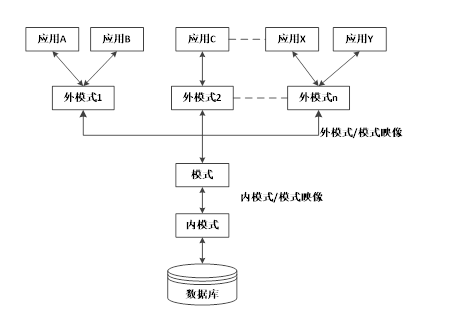
当前课程知识点:Database Technology and Programming > Chapter Ⅰ Data Management Technology – Database > 1.2 Database System > 1.2.3 Three-tier Mode of Database
返回《Database Technology and Programming》慕课在线视频课程列表
From a DBMS perspective, database systems usually adopt a Three-tier mode structure.
These three levels are composed of external mode, mode and internal mode.
1. Schema
The mode is also called the logical mode, which is a description of the logical structure and characteristics of all data in the database, and is a common data view of all users. It is the middle layer of the database system, which does not involve physical storage details and hardware environment, nor is it related to specific applications and languages.
2. External Schema
The external mode is also called a subschema (Subschema), which is a description of the logical structure and characteristics of the local data that the database user can see and use, and is a data view of the database user.
External mode is a powerful measure to ensure database security. Each user can only see and access the data in the corresponding external mode, and the rest of the data in the database is not visible.
3. Internal Schema
Internal mode is also called storage mode (Storage Schema). It is a description of the physical structure and storage method of data, and a way of representing data. For example, the storage method of records is sequential storage, storage in index order, storage in B-tree structure, etc.
Mapping
In order to be able to realize the connection and conversion of three abstract levels internally, the DBMS provides two layers of images between these three levels of patterns:
• External mode / mode mapping
• Mode / intra mode mapping
It is these two layers of mapping that ensure that the data in the database system can have a high degree of logical independence and physical independence.

返回《Database Technology and Programming》慕课在线视频列表
-From the beginning: Knowledge Point Puzzle of Chapter I
-1.1 Data & Data Management
--1.1.1 Data, Information and Databases
--1.1.2 Explore Data Management
-1.2 Database System
--1.2.3 Three-tier Mode of Database
-Exercise
-【Discussion: Will the database be replaced by blockchain? 】
-Knowledge Point Puzzle of Chapter Ⅱ
-2.1 Database Design
-2.2 Conceptual Structure Design
--2.2.1 Conceptual Structure Design
-2.3 Logical Structure Design
--2.3.1 Logical Structure Design
--2.3.2 Integrity Rules of Relational Model
--2.3.3 Transforming ER Model into Relational Model
-Exercise
-【Discussion: Structured data —— Relational model, Unstructured data——? 】
-Knowledge Point Puzzle of Chapter Ⅲ
-3.1 Create Databases
-3.2 Create Tables
-3.3 Maintain Tables
-Exercise
-【Discussion: What is the referential integrity?】
-Knowledge Point Puzzle of Chapter Ⅳ
-4.1 Data Types, Constants and Variables
--4.1.1 Data Types, Constants and Variables
-4.2 Expressions
--4.2.1 Numeric & Character Expressions
--4.2.2 Relational & Logical Expressions, Operation Priority
-4.3 Functions
--4.3.3 Date/Time, Conversion and Iif Functions
-Exercise
-Knowledge Point Puzzle of Chapter Ⅴ
-5.1 Query and Query Files
--5.1.1 Data Retrieval Method and Query Files
-5.2 Select Query
-5.3 Operation Query
-Exercise
-Knowledge Point Puzzle of Chapter Ⅵ
-6.1 Summary Of SQL
-6.2 Data Definition Language
--6.2.1 SQL Definition Language
-6.3 Data Query Language
-6.4 Data Manipulation Language
--6.4.1 SQL Manipulation Language
-Exerise
-Knowledge Point Puzzle of Chapter Ⅶ
-7.1 Form Design
-7.2 Report Design
--7.2.1 Report Structure and Create Report
-Exercise
-Knowledge Point Puzzle of Chapter Ⅷ
-8.1 VBA Programming
--8.1.1 VBA Programming Environment
-8.2 Sequence Structure
-8.3 Selection Structure
--8.3.2 The “Select Case” Statement & Nested Selection Structure
-8.4 Repetition Structure
--8.4.2 The “Do While” Statement
-8.5 Functions & Procedures
--8.5.1 Functions and Procedures
--8.5.2 Parameter Transmission
-8.6 VBA Debug
-8.7 Arrays
-Exercise
-Knowledge Point Puzzle of Chapter Ⅸ
-9.1 What is OOP?
-9.2 Properties, Methods and Events
--9.2.1 Properties, Methods and Events
--9.2.2 Event Trigger Sequence
-9.3 OOP Examples
--9.3.1 Object Synchronization
--9.3.4 Connect and Access Tables
-Exercise
-Knowledge Point Puzzle of Chapter Ⅹ
-10.1 What is a Macro?
--10.1.2 Commands and Classifications of Macro
-10.2 Create Macros
--10.2.1 Add New Action to a Macro
-10.3 Debugging and Conversion of Macro
--10.3.1 Debugging and Conversion of Macro
-Exercise
-Congradulations!Puzzle complete!
-11.1 Requirement Analysis of Database Application System
--11.1.1 System Design Process
--11.1.2 System Function Introduction
-11.2 Data Layer of Database Application System
--11.2.1 Underlying Data Structure
-11.3 Realization of Database Application System
--11.3.1 Registration and Login Module
--11.3.2 Get User Identity from Login Form
-11.4 Test and Release of Database Application System
--11.4.1 Test and Release of Database Application System
-Final Exam
